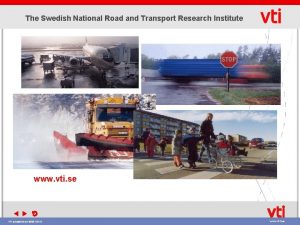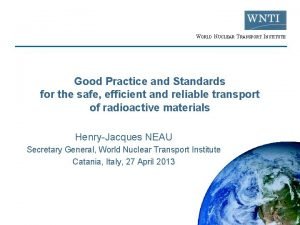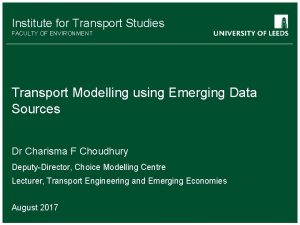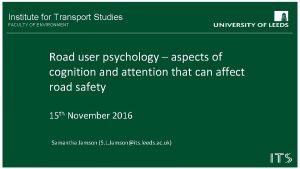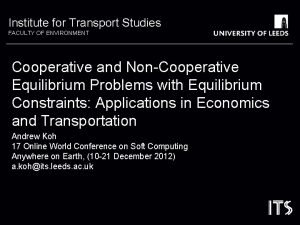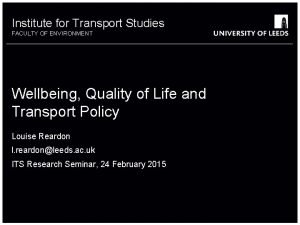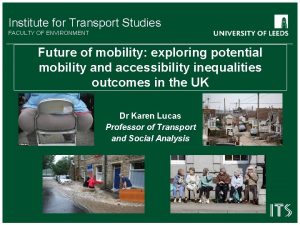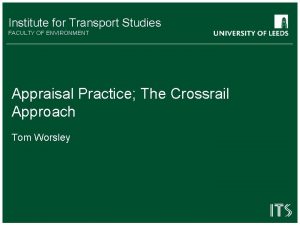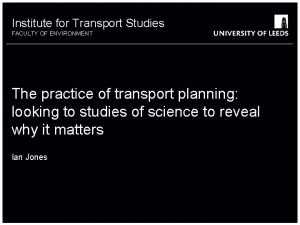Institute for Transport Studies FACULTY OF ENVIRONMENT Twenty


















- Slides: 18

Institute for Transport Studies FACULTY OF ENVIRONMENT Twenty years of research on Intelligent Speed Adaptation: from “white elephant” to gold stars 10 th November 2016 Samantha Jamson (S. L. Jamson@its. leeds. ac. uk)

Some definitions Intelligent Speed Adaptation: a system that advises or prevents drivers from exceeding the speed limit 2 White elephant: Gold stars: a possession that is useless or troublesome, especially one that is expensive to maintain or difficult to dispose of. Euro NCAP has created the five-star safety rating system to help consumers, their families and businesses compare vehicles more easily and to help them identify the safest choice for their needs

How did we get here? 3

Twenty years ago “The adoption of lower speed limits, enforced by variable speed limiters, will save lives and make our towns safer for all road users, especially children and old people. It will also reduce pollution and fuel consumption, weaken still further the case for major new roads, and minimise the need for police involvement in enforcement. Speed control is an immensely powerful instrument of transport policy which has so far been little exploited. ” Plowden and Hillman (1996) 4

Background to the ISA innovation • The well documented relationship between speed and accidents has led to the development of numerous interventions that attempt to reduce driver speed. • These interventions have traditionally employed the "three Es" of Education, Enforcement and Engineering. 5

Why don’t the “Es” provide a solution? Example - Engineering Traditional measures all have one thing in common – their effect is limited in time and space. They may be able to reduce speeds at “accident blackspots” but their ability to affect speeds globally is questionable. ISA is global. Its effect is only limited by the (geographical) size of the digital road map Traditional measures often contribute to visual clutter. Additional signage and road markings not only have financial implications relating to their installation and maintenance but can cause offence to local residents. ISA is invisible. Measures such as speed humps still “punish” law-abiding drivers. They are still an inconvenience even when travelling at the appropriate design speed. ISA is silent. It is a support system that does not intrude until the maximum allowable speed is reached. It does not affect the acceleration performance of the vehicle, only its top speed. Traditional measures are not flexible: cannot take into account time of day, day of the week etc. ISA can be dynamic. For example lower speed limits can be enforced during the school-run time, in the vicinity of the school only. In school holidays etc. the limits can be returned to normal. Weekend and off-peak regimes can also be applied. 6

My first presentation on ISA Comte, S. L. (1998). The effect of automatic speed control on driver behavioural adaptation. Proceedings of the 9 th International Conference of Road Safety in Europe, Bergisch Gladbach, Cologne, Germany. • The audience were in a state of disbelief • Vehicle manufacturers were totally opposed 7

Timeline of ISA projects 1999 2000 2001 2002 2003 ISA Trial, Gent INFATI Pay as you speed ISA trial LAVIA ISA Sweden MOTION ISA-UK London ISA Adapted from the FOTNET wiki (not exhaustive) 8 2004 2005 2006 2007 2008 2009

Early focus was on speed reduction • Reductions in maximum speed • Reductions in mean speed • Changes to speed distributions 9

Then other types of behaviour were investigated • Traffic violations • Reaction to surprise events • Overtaking • Following behaviour • Compliance (opt in or out of a voluntary system) Opt-out button 10

Those who turned the ISA off…. …. . were those who “needed” it most (young, males, speed intenders) 11

Accident prediction and cost-benefit analysis (2004) Two major scenarios Requirement to fit intervening ISA is introduced. As a result ISA penetration grows faster than in 2017 market driven scenario Target year for the authority driven scenario. 70% of new passenger 2025 cars and 100% of commercial vehicles fitted with intervening ISA 12 2005 In vehicle sat nav systems are available on the market 2010 High quality digital mapping with speed limit information is available 2020 All new vehicles are fitted with advisory ISA; intervening ISA is increasingly favoured Market driven Authority driven • Market driven (those who want ISA fit it) • Authority driven (encouragement and then compulsion)

Implementation of ISA in light vehicles under authority driven scenario 13

Predicted crash reductions under the authority driven scenario 14

Benefit to cost ratios (accidents, fuel and Co 2) Market driven scenario = 3. 4 Authority driven scenario = 7. 4 15

From research to deployment Euro. NCAP http: //etsc. eu/wp-content/uploads/4. -Euro. NCAP -and-Speed-Assistance-Systems-Marie. Brasseur-Euro-NCAP. pdf SLIF = Speed Limit Information Function MSA = Manual Speed Assist 16

We have come a long way…. . 17 / http: //www. rospa. com/campaigns-fundraising/success/seatbelts

But still progress to be made Thank you for your attention! 18
 University of split faculty of maritime studies
University of split faculty of maritime studies Paradigm shift from women studies to gender studies
Paradigm shift from women studies to gender studies Symport
Symport Active transport
Active transport Now answer the following questions
Now answer the following questions Active transport vs passive transport venn diagram
Active transport vs passive transport venn diagram Unlike passive transport, active transport requires *
Unlike passive transport, active transport requires * Primary active transport vs secondary active transport
Primary active transport vs secondary active transport Bioflix activity membrane transport active transport
Bioflix activity membrane transport active transport Active transport and passive transport
Active transport and passive transport Isotonic in biology
Isotonic in biology Institute for prospective technological studies
Institute for prospective technological studies Philippine institute for development studies
Philippine institute for development studies Swedish national road and transport research institute
Swedish national road and transport research institute World nuclear transport institute
World nuclear transport institute Ciwem membership
Ciwem membership Financial environment in business environment
Financial environment in business environment Fspos
Fspos Typiska novell drag
Typiska novell drag













